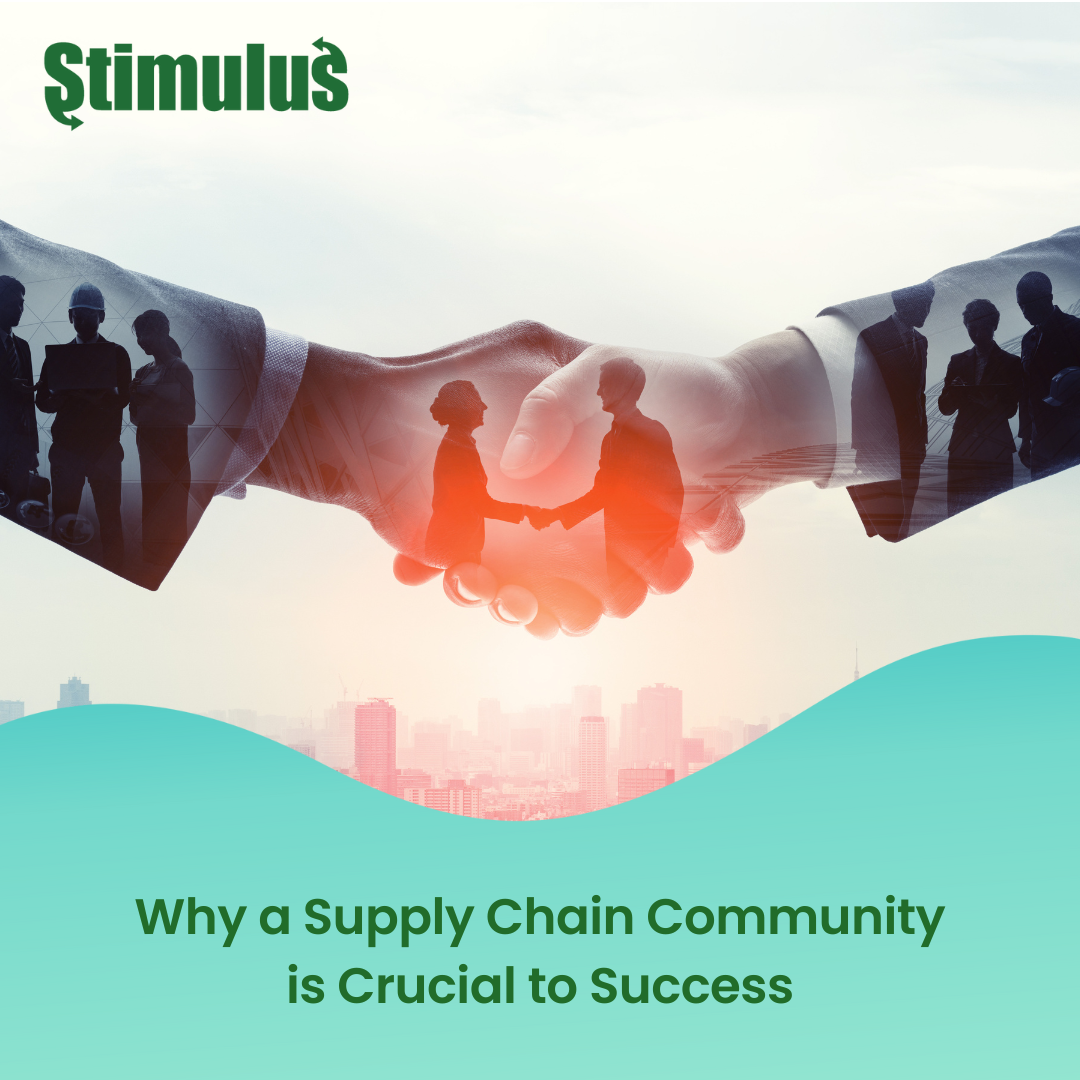Unlocking the Power of Sustainability and Green Supply Chain Management
.png)
The supply chain market is one that is constantly changing to meet the needs of the people and the current social and economic climate. With the pandemic, the supply chain became far more diversified and localized, while ‘The Great Resignation’ led to the building of stronger supplier relationships and more emphasis on automation. Now, a new transition is occurring thanks to a strong emphasis on eco-friendly practices and sustainability as a whole by society.
More than ever before, consumers are looking to work solely with sustainable brands that have green supply chains and eco-conscious practices. To meet these expectations, companies must understand the impact of ignoring these needs, what it means to be truly sustainable, and the best steps to take in order to build a green supply chain management system. In this article, we at Stimulus have taken the time to break down all of the above in hopes of helping brands hop on the sustainability bandwagon while they can and reap the benefits. To start, let’s take a closer look at what being ‘unsustainable’ can lead to for our society, environment, and brand success below.
The Impact of ‘Unsustainability’ in the Supply Chain Market
Sustainability has become a critical aspect of business operations as the impact of unsustainable practices on the environment and society has become more evident. In the supply chain market, unsustainable practices can lead to environmental degradation, social inequality, and economic instability. Companies that fail to adopt sustainable practices can face reputational damage, regulatory fines, and loss of market share.
From a long-term perspective, the impact of unsustainability in the supply chain market can have devastating consequences on our environment. The use of non-renewable resources and the emission of greenhouse gases contribute to climate change, which is causing extreme weather events, rising sea levels, and loss of biodiversity. These environmental changes have ripple effects on our society, including food and water scarcity, displacement of people, and increased healthcare costs. In turn, this can lead to economic instability, as businesses are affected by disrupted supply chains and declining consumer demand.
The effect of unsustainability is felt across all industries. For example, the fashion industry is one of the most significant contributors to global pollution, with textile production accounting for 10% of global carbon emissions. The use of non-biodegradable fabrics and harsh chemicals in production has also led to soil and water pollution, posing risks to human health and ecosystems. Unsustainable practices in the agriculture industry, such as deforestation and the use of pesticides, not only harm the environment but also affect food security and social inequality.
Moreover, company success and reputation are at stake with the impact of unsustainability in the supply chain market. Consumers are increasingly becoming aware of the negative impact of unsustainable practices and are demanding more responsible business practices. A company that fails to adopt sustainable practices may lose customers to competitors who prioritize sustainability. Additionally, regulatory bodies enforce stricter environmental and social regulations, and companies that do not comply can face legal and financial consequences. The failure to address sustainability issues in the supply chain can also lead to reputational damage, which can take years to recover from.
What it Means to Have a Truly Sustainable Supply Chain
A truly sustainable supply chain is one that minimizes negative environmental and social impacts while maximizing economic benefits. To achieve this, companies must work collaboratively with suppliers, customers, and stakeholders to identify opportunities to reduce waste, improve efficiency, and promote ethical practices. It requires a long-term commitment to continuous improvement and a willingness to invest in new technologies and processes.
To achieve a sustainable supply chain model, companies should start by evaluating their current supply chain operations and identifying areas of improvement. This includes assessing the sustainability of their suppliers, transportation methods, and packaging materials, among other factors. Companies should set sustainability goals and work to align their supply chain operations with these goals.
A critical aspect of a sustainable supply chain model is the use of renewable energy sources and the reduction of greenhouse gas emissions. Companies can achieve this by adopting energy-efficient transportation methods, such as electric or hybrid vehicles, and using renewable energy sources like solar or wind power. Another important aspect is using sustainable materials and packaging, such as recyclable or biodegradable materials.
Companies can also prioritize social responsibility in their supply chain operations by ensuring fair labor practices and safe working conditions for their employees and suppliers. This includes promoting diversity and inclusion in their workforce and supply chain network.
Unfortunately, some companies may falsely claim that their supply chains are sustainable when, in reality, they are not. These companies may engage in practices that may not be sustainable but market themselves as environmentally friendly to appeal to consumers who prioritize sustainability. This is known as "greenwashing," which is the practice of making false or exaggerated claims about the environmental benefits of a product or service.
Truly sustainable supply chains, on the other hand, are characterized by a holistic approach that considers the social, environmental, and economic impacts of their operations. These companies prioritize reducing their environmental footprint, promoting social responsibility, and adopting ethical business practices throughout the supply chain. They may also prioritize sustainable sourcing, reducing waste, and implementing green technology to minimize their environmental impact. Ultimately, truly sustainable supply chains prioritize transparency, and they are open about their sustainability efforts, allowing stakeholders to hold them accountable for their actions.
To see how these companies ensure their sustainability, let’s take a look at some of the most surefire methods for a green supply chain below that you and your team can take even now to improve your eco-friendly practices with ease.
How to Develop a Green Supply Chain Management Model
Developing a green supply chain management model is not only essential for reducing environmental impacts but also for improving business operations and reputation. While it may seem daunting to transition to a more sustainable supply chain, there are several definitive and easy-to-start ways that companies can begin to go green effectively this year. By implementing the following six options, businesses can reduce waste, improve efficiency, and achieve a more sustainable and green supply chain in no time.
- Measure your carbon footprint
Conduct a comprehensive analysis of your supply chain to identify areas of high emissions and set reduction targets. Use data analytics to track progress and measure the impact of sustainability initiatives.
- Partner with eco-friendly suppliers
Work with suppliers who have a strong commitment to sustainability and ethical practices. Use the Stimulus Relationship Intelligence Platform (SRIP) to identify suppliers that meet your sustainability criteria and promote supplier diversity.
- Optimize transportation and logistics
Implement efficient transportation and logistics systems that reduce carbon emissions and minimize waste. Use GPS and RFID technology to track shipments and improve routing and scheduling.
- Reduce waste and promote circularity
Adopt circular economy principles to reduce waste and maximize resource efficiency. Implement recycling programs and incentivize suppliers to reduce packaging waste.
- Implement sustainable product design
Develop products with sustainability in mind, from sourcing to disposal. Use eco-friendly materials and design products that can be easily repaired, reused, or recycled.
How SRIP can Help Build a Green Supply Chain
The Stimulus Relationship Intelligence Platform (SRIP) can help companies build a green supply chain by providing data-driven insights that enable them to make informed purchasing decisions. SRIP combines data insights, relationship-building tools, and a proprietary score to help companies optimize and grow their supplier network. By leveraging data from internal and external sources, SRIP can increase visibility, enhance decision-making, and promote communication of supplier utilization. This allows teams to avoid risks and lower costs by identifying opportunities and disruptions across the supply chain in real time. Using SRIP, companies can easily compare suppliers based on sustainability criteria such as location-based and diversity, making it easier to choose eco-friendly suppliers and fulfill sustainability objectives.
Ultimately, the importance of sustainability and green supply chain management cannot be overstated in today's business landscape. It is not just a moral obligation but a critical factor for long-term success and resilience. Companies that embrace sustainable practices and incorporate them into their supply chain management can enjoy numerous benefits, including reduced costs, improved efficiency, enhanced reputation, and increased customer loyalty. By implementing the six options discussed in this article, companies can take a significant step towards achieving a truly sustainable and green supply chain. And with the help of advanced technology solutions such as the Stimulus Relationship Intelligence Platform (SRIP), companies can further optimize their supply chain, reduce risks, and achieve their sustainability goals. By working together toward a greener future, we can build a more resilient, equitable, and sustainable world for future generations without breaking the bank.

.png)
.png)
